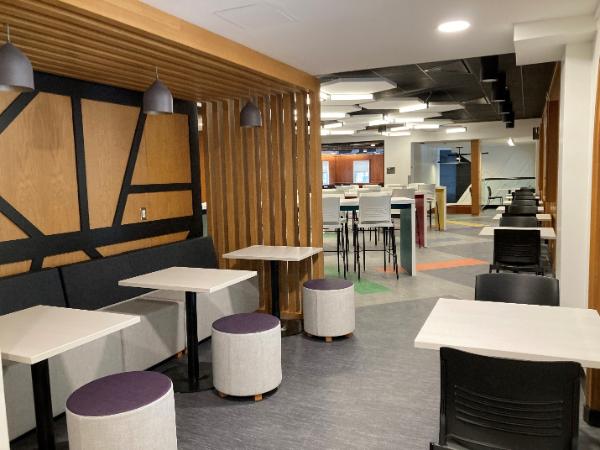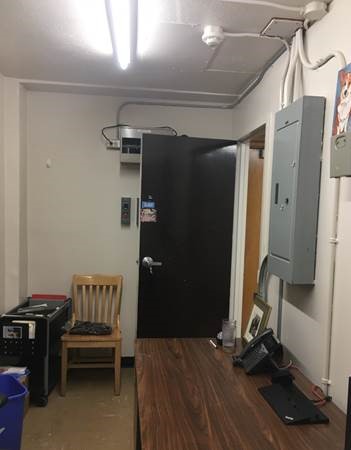Dining Hall Transformation
Turning an idea into reality
How does a dated, decades old meeting space turn into a bright, modern and functional dining and multipurpose area that still keeps its 1960s charm?
Gina Myrick, a project coordinator with Facilities Engineering and Development (FED), designed the new vision for the space aided by Mike Foley, manager, minor capital projects with design input from Austin St. John, co-ordinator. Myrick led a team of external contractors as well as Facilities Management’s in-house trades.
Sustainable design choices: recycle and reuse
A number of the design choices were made with sustainability in mind.
Most of the rooms’ iconic oak wall paneling remains, giving it a new life. Brighter, contrasting paint colours, flooring and furnishings break up the previous single colour tone of the wood while animating and brightening the spaces. Likewise, the existing stairwell to the area was closed in, dark and uninviting, so walls were removed from an adjacent office space creating an open landing and additional seating.
“Committing to a sustainable approach to design and construction is something me and my team have always taken seriously and will continue to do so for all projects,” says Foley. When renovating areas, many good condition items such as flooring and doors can often be saved,re-used or up-cycled for future projects.
Adding value and function to the space, two fully accessible, gender inclusive washrooms were added. Touchless operational capabilities on the door operators, faucets and paper towel dispensers were included in the new washrooms and added to ones already existing.
Feeling connected: Spatially and technologically
It was important to create a space that felt connected to the main dining hall below. To accomplish this, the existing ornamental glass from the arched windows was removed. The ornamental iron railing was kept and additional glass railings installed to meet building code.
Collaborating with Student Life and CITL Classroom Technologies, technology requirements and integration insured the space was flexible to the various student needs. This includes a new audiovisual system and the latest in digital technologies to support presentations, collaboration and video-conferencing. The result is a modern, multipurpose space that will be used for a variety of activities.
More information and photos of the construction process can be found in an earlier Gazette article.
 was removed but the doors were saved and reused to create a wall feature in the banquette shown below.-612x457.jpg)
Photo Credit: Gina Myrick. The double door at the entrance to the area (shown on the left of the above photo) was removed but the doors were saved and reused to create a wall feature in the banquette shown below.

Photo Credit: Gina Myrick. Black accent molding was used to cover the doors’ lockset holes and vertical joints between each door. The door on the right with the grill (above photo) was also re-used as the door to a new audio-visual closet.

Photo Credit: Gina Myrick. Office space with existing electrical panel that was seamlessly incorporated into the design.

Photo Credit: Gina Myrick. Existing oak wall panels were removed in the main lobby and were re-used to create an angled wall that looks original to the building. Same space, opened up. The original electrical panel remained in place and was painted to match Memorial’s electrical standards.